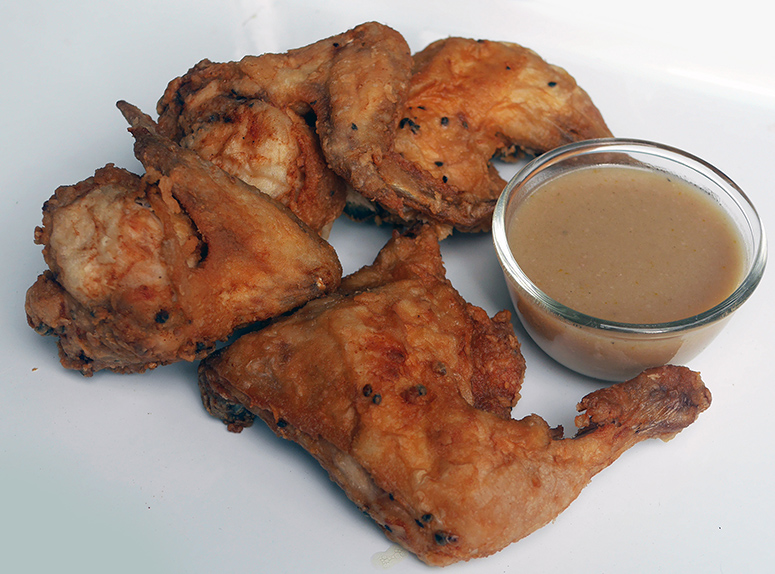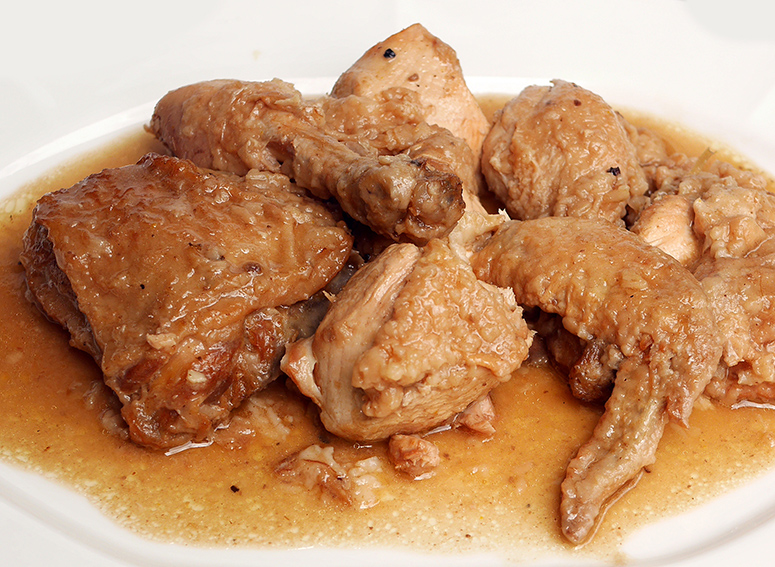AROUND THE WORLD IN 80 FILIPINO ADOBOS
Bencab’s grilled adobo and other unique versions
More and more adobo stories come trickling in. Though they may be separated by great distances and time zones, with their respective adobo dishes so disparate in ingredients, preparation and appearance, one would wonder what they could possibly have in common.
It’s the vinegar, darling.
I’ve written it so many times before, that in Filipino cooking, the dish conforms to the maker, and is not a codified recipe. The creativity of the Pinoy cook knows no bounds.
Grilled adobo, anyone? National Artist Bencab shared his adobo story over a phone conversation: “When I first moved to London in 1969, I was the designated home cook, being a work-from-home artist. I tried to replicate my mother’s chicken and pork adobo as best as I could. My parents were from Guagua and Sasmuan, Pampanga, and my mom’s adobo had toyo and coarsely mashed chicken liver mixed into the sauce. Of course, I didn’t know at that time it was a typical Kapampangan adobo with the inclusion of chicken liver. But for me, it was the only adobo I knew, and it was the best adobo because my mother cooked it. I just added the grilling part to have that smoky flavor from the charred edges of the meats.

“Here's how I do it: Marinate overnight chicken wings (my favorite chicken part), chicken liver, and liempo (fatty pork belly with skin is a must for the linamnam it imparts), with vinegar, toyo, whole black peppercorns, and lots of crushed garlic. Next day, place the marinated meats in a pot, add some water and simmer over a low fire until tender. Separate meats from sauce. Grill meats over a charcoal grill until lightly charred, basting it with some of the adobo sauce. Meanwhile, mash coarsely with a fork the grilled chicken liver and mix with the sauce. Simmer for a few minutes until a gravy-like consistency is achieved. At this stage, you can coat the grilled meats with the sauce, or serve it on the side in a sauceboat.”
One can’t take the Kapampangan out of this world-renowned artist.
This recipe speaks of my childhood, taking me back to our ancestral home in Manila where two bountiful mango trees stand and reminding me of my grandfather.
Fried chicken adobo/Adobo con salsa: This adobo recipe was brought to light by food historian Felice Sta. Maria. It is from an American cookbook published in 1928. Sta. Maria reports the recipe was written by Isidra Baldomero, wife of Pedro Guevara, Philippine Commissioner to the USA from 1923-1937. As a Commissioner, he was a member of the US Congress. It was considered a coup that Philippine recipes would be included in the famous Congressional Cook Book of congressional spouses.

Mrs. Guevara’s chicken adobo is twice cooked, first boiled in vinegar, water, salt and pepper, for 40 minutes (note: no garlic and bay leaf). When done, the chicken pieces are coated with flour and fried in lard. At this stage, it can be served as a fried chicken dish. Alternatively, a third cooking step involves the fried chicken pieces being placed back in the pot where they were boiled, and simmering for an additional 10 minutes. The flour coating the chicken pieces acts as a thickener for the sauce. Mrs. Guevara wrote this kind of adobo is called Adobo Con Salsa, or adobo with gravy — something the mainly American readers can relate to, albeit a somewhat acidic gravy. (From The Philippine Republic, 1928. Felice Sta. Maria’s vintage Filipino cookbook collection has been donated to the Lopez Library.)

Minanggang Adobo Balsamico by Keesa Ocampo, Filipino Food Movement vice president, California: “Strictly speaking, adobo isn't a recipe but a cooking technique. As ubiquitous as it is to global Filipino cuisine, each household's family recipe is as unique and exciting as the next because of the stories they tell. That's what's most intriguing to me: yung kwento.
This recipe speaks of my childhood, taking me back to our ancestral home in Manila where two bountiful mango trees stand and reminding me of my grandfather, who used to say he counted the fruit from his bedroom window. Living in California, I'm always looking for ways to recreate home. Inasmuch as this recipe transports me, it represents all of me: my past, present and future.

The recipe's balsamic vinegar and very ripe mangoes add a sweetness that balances out the adobo's acidity. The simplicity of the process fits my lifestyle as a new mom — an uncomplicated, one-pot dish requiring minimal cleanup. I use ingredients available to us: Modena balsamic vinegar, "Manila" mangoes from Mexico, and fresh, cinnamon-y California bay leaves, while chasing the perfect balance between tamis-asim (sweet/sour). No matter where Filipinos cook around the world, we remember the basics: smash the garlic before mincing to release the oils, leave the vinegar alone until it boils, and always serve adobo with rice.”
For her chicken adobo recipe, Keesa uses all 1.5 lbs. (approx. 750 g) thighs, 1/4 cup balsamic vinegar and 1/2 cup apple cider, garlic, bay leaves, a teaspoon of patis, salt and pepper to taste. The thighs are first braised in olive oil until brown on both sides. Set aside. Using the same pan, minced garlic is sautéed, then add balsamic and apple cider vinegars and bay leaves, allowing acidity to evaporate. Browned thighs are placed back into the pan, and simmered to a low boil. Some garlic powder is added; fish sauce and season to taste with salt and pepper. Chopped ripe mango cheeks are added last, continuing simmering until the sauce slightly thickens. At home, Keesa always pairs this with jasmine rice and Brussels sprouts sautéed in butter.
Chef Dean Patrick Ramirez, owner of the Lone Crow in Union City, California: “Adobo is a dish that is all too familiar to me. I grew up eating it weekly, which was cooked by my mom. It made me feel complete and at home, as it is a dish that brings comfort to my soul.

I was able to taste different versions of adobo; from my mom’s version to my aunts’, everyone had a unique spin on it. Because it is one of my favorite dishes in the Filipino culture, I wanted to experiment and create my own version of it. By using my skills from culinary school, experiences of working in different restaurants, and a very strong palate for flavor, I was able to create an adobo dish of my own that brought the same feeling of comfort and hominess to my own family and household."
For my adobo, I use all chicken thighs. Season first with salt and pepper, then pan-sear until brown. Set aside. Using same pan, sauté lots of cubed onions and minced garlic until translucent. Add dried Thai chili, peppercorns and bay leaves, sauté (heating the spices will bring out the flavor and aromatics). Add your liquids (soy sauce, vinegar, water) after a few minutes and wait till it boils. When boiling, lower heat back down and add eggs to boil for 7 minutes. Transfer the eggs to ice water to stop the cooking and peel. Add the chicken back in and cook for 15 minutes then add the potatoes and peeled boiled eggs. Continue simmering for another 15 minutes. Cool down. Garnish with fried garlic and scallions when serving.
Get the full recipe @deanpatrickramirez @the.lone.crow TheloneCrow.com.
Adobo Filipino con sofrito: During my last visit to Restaurante Sobrino de Botin in Madrid, in November 2021, its maestro asador (chief roaster), my kabalen Michael Alim, shared this about the Spanish adobo: “Although we don’t serve any adobado or marinated meats in Botin, we do have it in our weekly staff meal schedule, like cinta de lomo adobado (pork loin), cerdo adobado (pork), chuletas adobada (pork chops), etc. These are all marinated meats ready for grilling, frying, or filling for empanadas.”

It seems that the adobados or marinated meats don’t take center stage in Spanish restaurants, or, at least shyly remain on the sidelines as go-to comfort food for the kitchen staff and the home cook, lest it be compared to the customer’s adobado de su mamá, quizas?
Michael said that Pinoy adobo is always on their home menu. But the truth is, he hastened to add, that his brother Ruel, sister-in-law, mom and he each have a different style of cooking adobo. Mom’s is somewhat sweet just like humba, since she’s Visayan. His brother Ruel, also a maestro asador in Botin, puts ginger in his, a bit spicy and with sauce. His wife’s is adobo sa puti. Michael likes his adobo a bit oily, spicy-hot, sweetish and with banana blossom. He marinates it first with vinegar, soy sauce and black pepper. It is then braised until its fat is rendered then the marinade and some water is finally added to simmer it until tender and liquid has almost evaporated.
He’s cooked pork adobo for the restaurant’s staff meal but they don’t like soy sauce, he said. Basically, it’s an adobo sa puti, with paprika and sofrito added to it, un sabor that every Spaniard can relate to.



